In Vitro Metabolic Fate of the Synthetic Cannabinoid Receptor Agonists QMPSB and QMPCB (SGT-11) Including Isozyme Mapping and Esterase Activity
Abstract
1. Introduction
2. Results and Discussion
2.1. Identification of In Vitro Phase I and II Metabolites of QMPSB
2.2. Identification of In Vitro Phase I and II Metabolites of QMPCB
2.3. Proposed Metabolic Pathways of QMPSB
2.4. Proposed Metabolic Pathways of QMPCB
2.5. Monooxygenase Activity Screening of QMPSB and QMPCB
2.6. Esterases Activity Screening with Recombinant hCES1b, hCES1c, hCES2, pHLM, and pHLS9
3. Materials and Methods
3.1. Chemicals and Reagents
3.2. pHLS9 Incubations for Investigation of Phase I and II Metabolites
3.3. Monooxygenase Activity Screening
3.4. Esterase Activity Screening with Recombinant hCES1b, hCES1c, hCES2, pHLM, and pHLS9
3.5. LC-HRMS/MS Settings
4. Conclusions
Supplementary Materials
Author Contributions
Funding
Institutional Review Board Statement
Informed Consent Statement
Data Availability Statement
Acknowledgments
Conflicts of Interest
References
- UNODC. Current NPS Threats. 2020, Volume III. Available online: https://www.unodc.org/documents/scientific/Current_NPS_Threats_Vol.3.pdf (accessed on 15 June 2021).
- EMCDDA. European Drug Report. 2020. Available online: https://www.emcdda.europa.eu/system/files/publications/13236/TDAT20001ENN_web.pdf (accessed on 15 June 2021).
- EMCDDA. Perspectives on Drugs, Synthetic Cannabinoids in Europe. Available online: https://www.emcdda.europa.eu/system/files/publications/2753/POD_Synthetic%20cannabinoids_0.pdf (accessed on 15 June 2021).
- Lambeng, N.; Lebon, F.; Christophe, B.; Burton, M.; De Ryck, M.; Quere, L. Arylsulfonamides as a new class of cannabinoid CB1 receptor ligands: Identification of a lead and initial SAR studies. Bioorg. Med. Chem. Lett. 2007, 17, 272–277. [Google Scholar] [CrossRef] [PubMed]
- Ermann, M.; Riether, D.; Walker, E.R.; Mushi, I.F.; Jenkins, J.E.; Noya-Marino, B.; Brewer, M.L.; Taylor, M.G.; Amouzegh, P.; East, S.P.; et al. Arylsulfonamide CB2 receptor agonists: SAR and optimization of CB2 selectivity. Bioorg. Med. Chem. Lett. 2008, 18, 1725–1729. [Google Scholar] [CrossRef] [PubMed]
- Blakey, K.; Boyd, S.; Atkinson, S.; Wolf, J.; Slottje, P.M.; Goodchild, K.; McGowan, J. Identification of the novel synthetic cannabimimetic 8-quinolinyl 4-methyl-3-(1-piperidinylsulfonyl)benzoate (QMPSB) and other designer drugs in herbal incense. Forensic Sci. Int. 2016, 260, 40–53. [Google Scholar] [CrossRef] [PubMed]
- Brandt, S.D.; Kavanagh, P.V.; Westphal, F.; Dreiseitel, W.; Dowling, G.; Bowden, M.J.; Williamson, J.P.B. Synthetic cannabinoid receptor agonists: Analytical profiles and development of QMPSB, QMMSB, QMPCB, 2F-QMPSB, QMiPSB, and SGT-233. Drug Test Anal. 2021, 13, 175–196. [Google Scholar] [CrossRef] [PubMed]
- Uchiyama, N.; Matsuda, S.; Kawamura, M.; Kikura-Hanajiri, R.; Goda, Y. Two new-type cannabimimetic quinolinyl carboxylates, QUPIC and QUCHIC, two new cannabimimetic carboxamide derivatives, ADB-FUBINACA and ADBICA, and five synthetic cannabinoids detected with a thiophene derivative α-PVT and an opioid receptor agonist AH-7921 identified in illegal products. Forensic Toxicol. 2013, 31, 223–240. [Google Scholar] [CrossRef]
- Richter, L.H.J.; Maurer, H.H.; Meyer, M.R. New psychoactive substances: Studies on the metabolism of XLR-11, AB-PINACA, FUB-PB-22, 4-methoxy-alpha-PVP, 25-I-NBOMe, and meclonazepam using human liver preparations in comparison to primary human hepatocytes, and human urine. Toxicol. Lett. 2017, 280, 142–150. [Google Scholar] [CrossRef] [PubMed]
- Diao, X.; Scheidweiler, K.B.; Wohlfarth, A.; Pang, S.; Kronstrand, R.; Huestis, M.A. In vitro and in vivo human metabolism of synthetic cannabinoids FDU-PB-22 and FUB-PB-22. AAPS J. 2016, 18, 455–464. [Google Scholar] [CrossRef] [PubMed][Green Version]
- Holsztynska, E.J.; Domino, E.F. Biotransformation of phencyclidine. Drug Metab. Rev. 1985, 16, 285–320. [Google Scholar] [CrossRef] [PubMed]
- Michely, J.A.A.; Manier, S.K.; Caspar, A.T.; Brandt, S.D.; Wallach, J.; Maurer, H.H. New psychoactive substances 3-methoxyphencyclidine (3-MeO-PCP) and 3-methoxyrolicyclidine (3-MeO-PCPy): Metabolic fate elucidated with rat urine and human liver preparations and their detectability in urine by GC-MS, “LC-(High Resolution)-MSn” and “LC-(High Resolution)-MS/MS”. Curr. Neuropharmacol. 2017, 15, 692–712. [Google Scholar] [CrossRef]
- Wang, J.; Williams, E.T.; Bourgea, J.; Wong, Y.N.; Patten, C.J. Characterization of recombinant human carboxylesterases: Fluorescein diacetate as a probe substrate for human carboxylesterase 2. Drug Metab. Dispos. 2011, 39, 1329–1333. [Google Scholar] [CrossRef] [PubMed]
- Thomsen, R.; Rasmussen, H.B.; Linnet, K.; Consortium, I. In vitro drug metabolism by human carboxylesterase 1: Focus on angiotensin-converting enzyme inhibitors. Drug Metab. Dispos. 2014, 42, 126–133. [Google Scholar] [CrossRef] [PubMed]
- Thomsen, R.; Nielsen, L.M.; Holm, N.B.; Rasmussen, H.B.; Linnet, K.; Consortium, I. Synthetic cannabimimetic agents metabolized by carboxylesterases. Drug Test. Anal. 2015, 7, 565–576. [Google Scholar] [CrossRef] [PubMed]
- Chauret, N.; Gauthier, A.; Nicoll-Griffith, D.A. Effect of common organic solvents on in vitro cytochrome P450-mediated metabolic activities in human liver microsomes. Drug Metab. Dispos. 1998, 26, 1–4. [Google Scholar] [PubMed]
- Wagmann, L.; Meyer, M.R.; Maurer, H.H. What is the contribution of human FMO3 in the N-oxygenation of selected therapeutic drugs and drugs of abuse? Toxicol. Lett. 2016, 258, 55–70. [Google Scholar] [CrossRef] [PubMed]
- Meyer, M.R.; Schutz, A.; Maurer, H.H. Contribution of human esterases to the metabolism of selected drugs of abuse. Toxicol. Lett. 2015, 232, 159–166. [Google Scholar] [CrossRef] [PubMed]
- Helfer, A.G.; Michely, J.A.; Weber, A.A.; Meyer, M.R.; Maurer, H.H. Orbitrap technology for comprehensive metabolite-based liquid chromatographic-high resolution-tandem mass spectrometric urine drug screening—Exemplified for cardiovascular drugs. Anal. Chim. Acta 2015, 891, 221–233. [Google Scholar] [CrossRef] [PubMed]

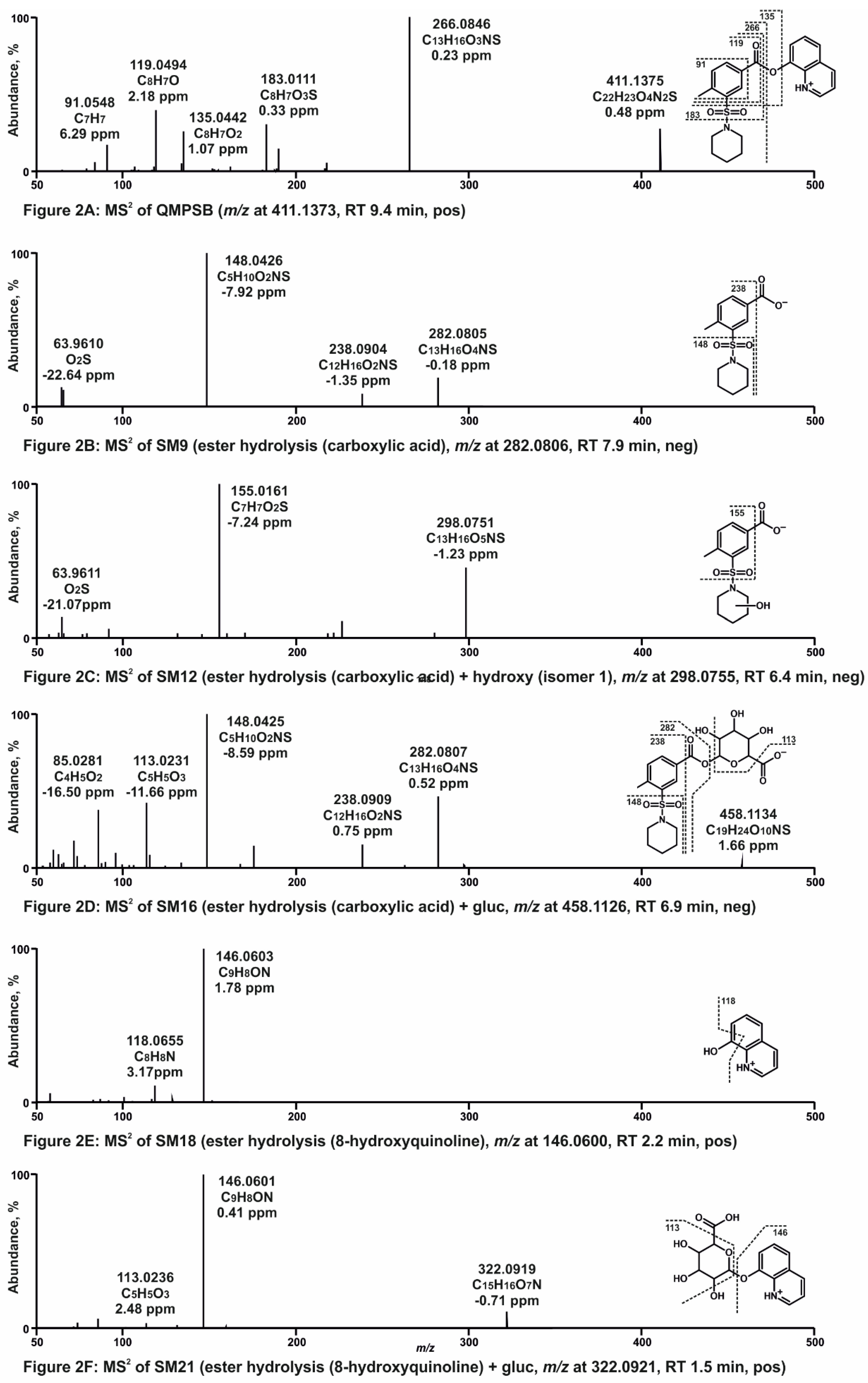
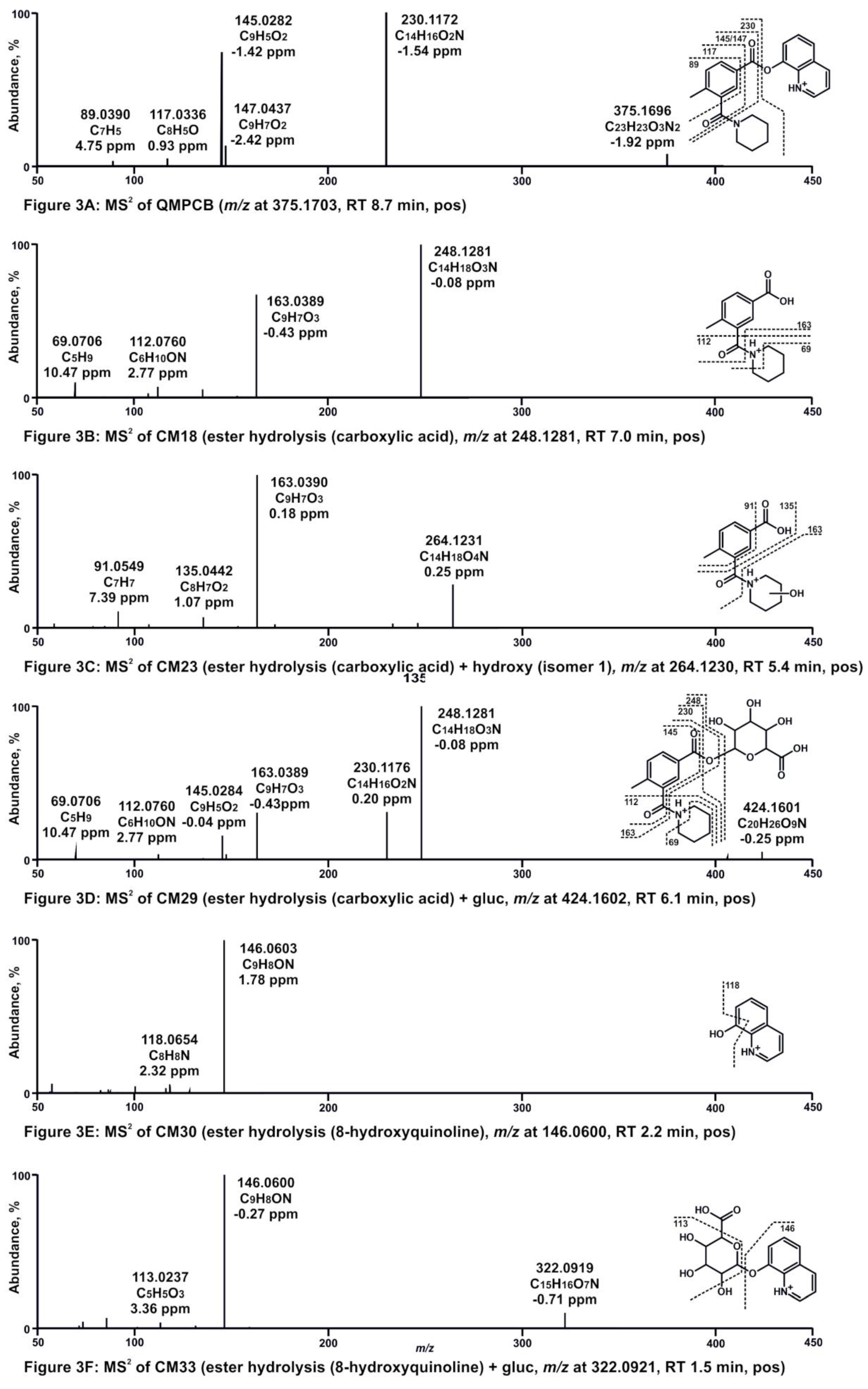
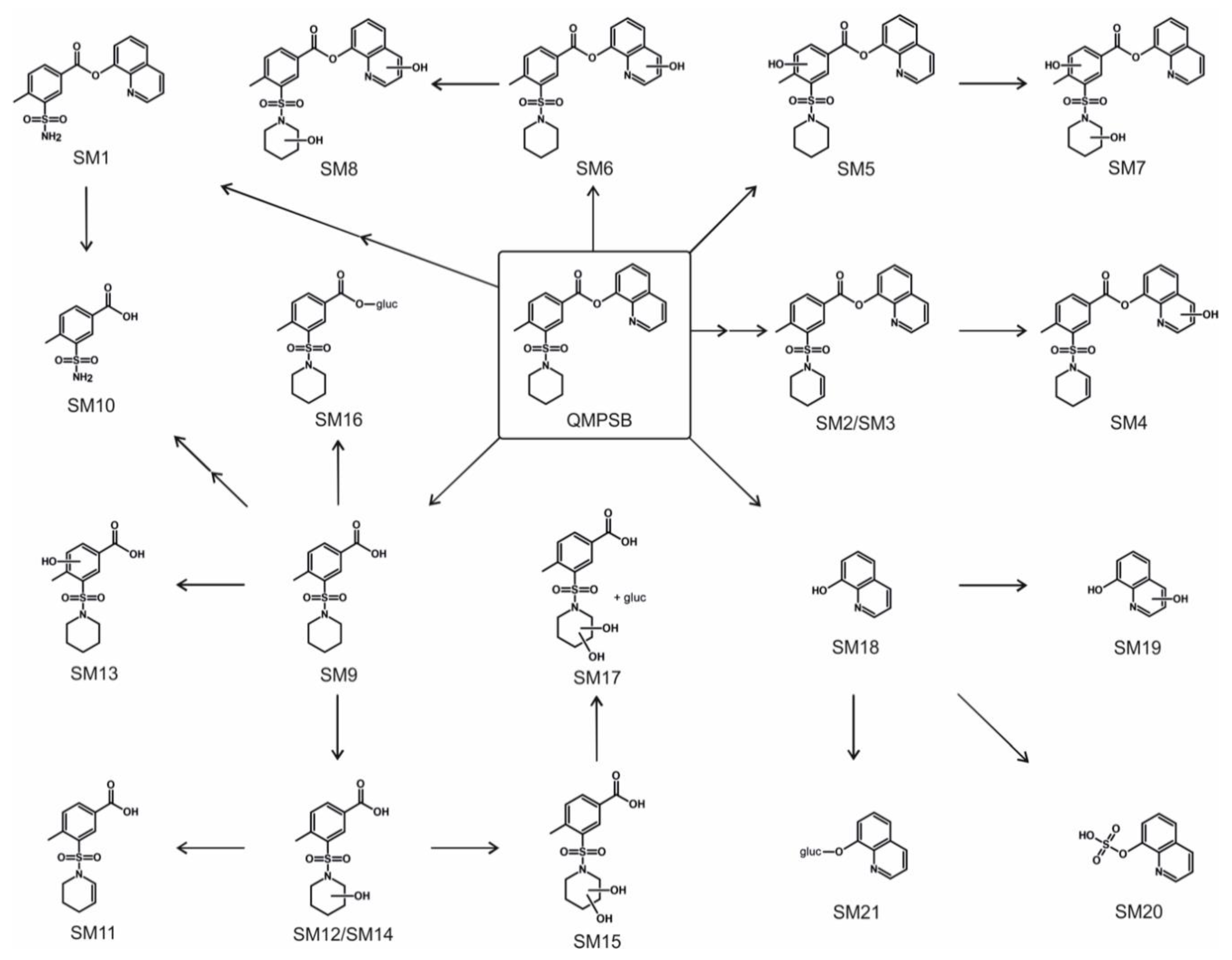
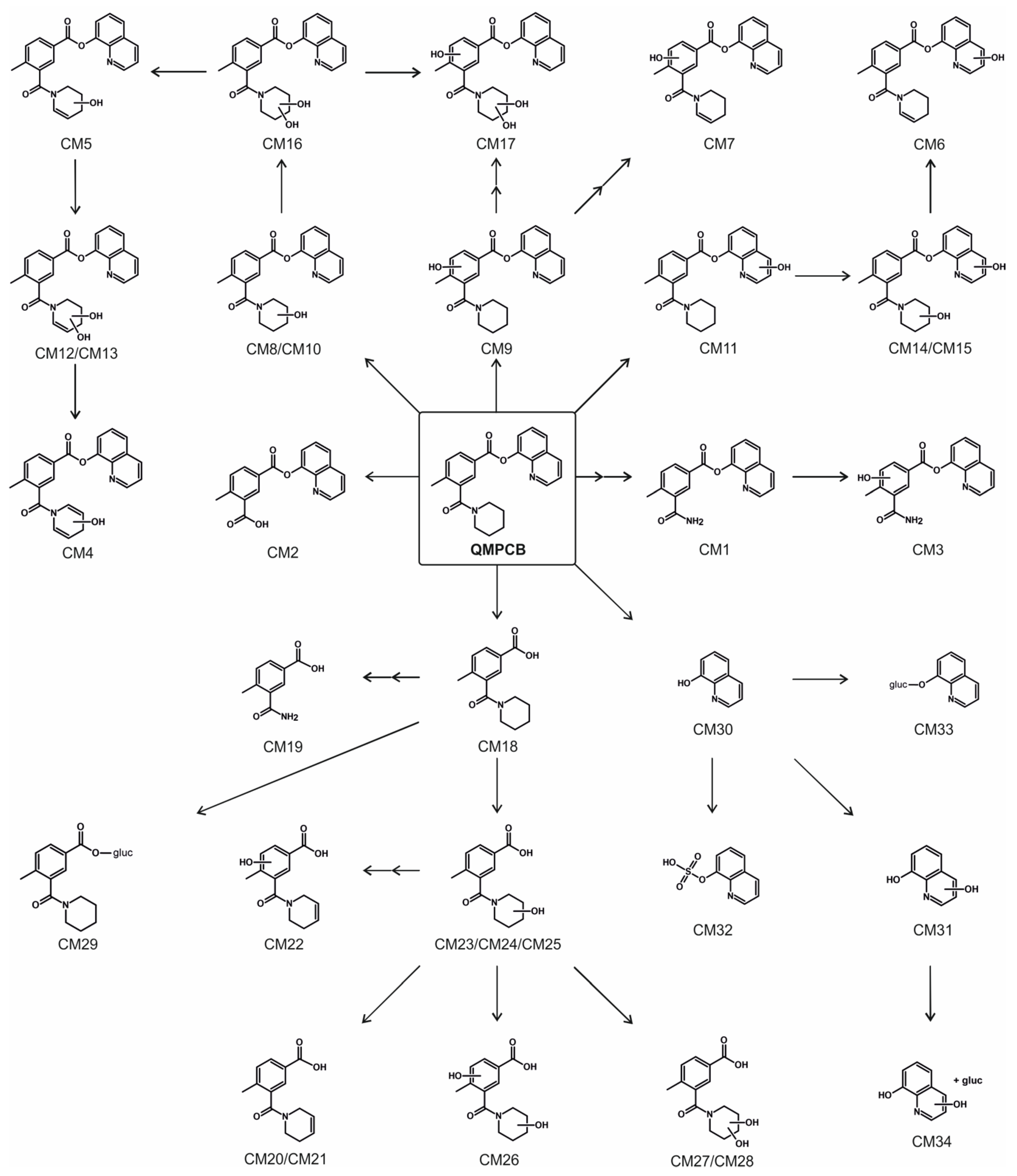
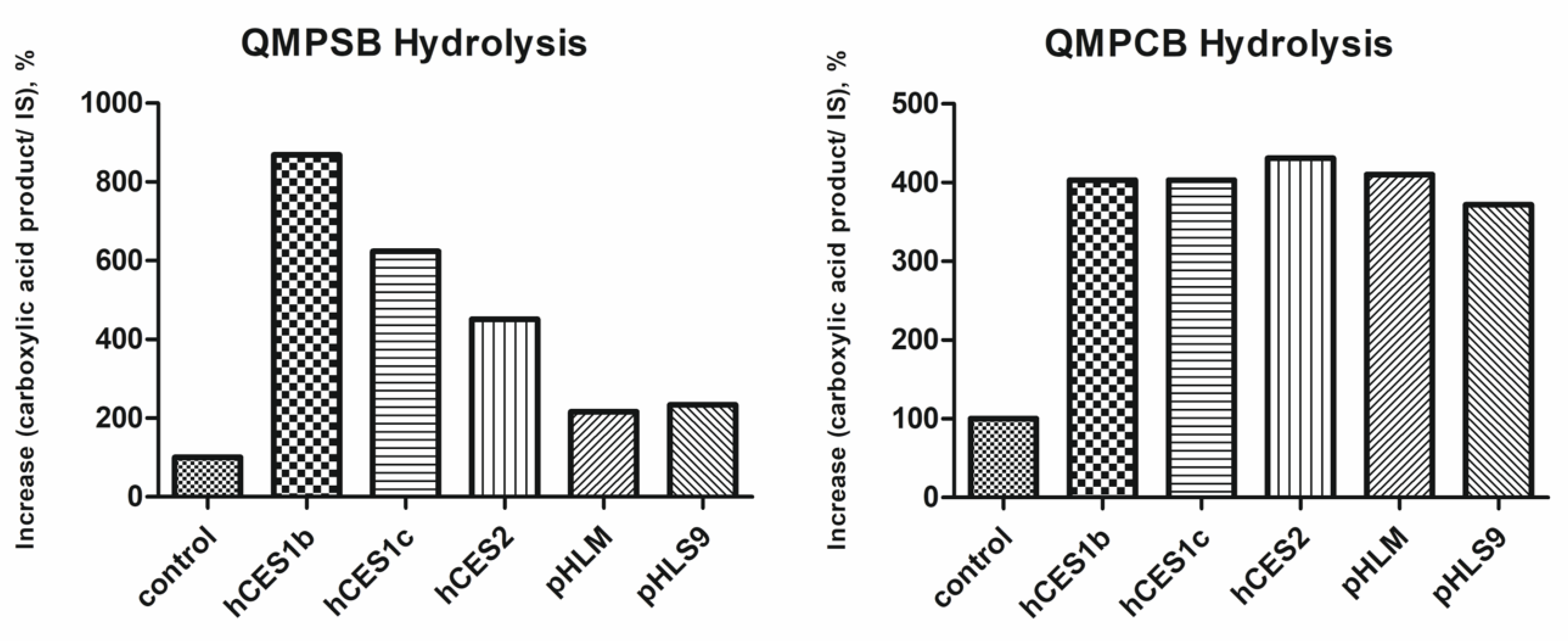
Publisher’s Note: MDPI stays neutral with regard to jurisdictional claims in published maps and institutional affiliations. |
© 2021 by the authors. Licensee MDPI, Basel, Switzerland. This article is an open access article distributed under the terms and conditions of the Creative Commons Attribution (CC BY) license (https://creativecommons.org/licenses/by/4.0/).
Share and Cite
Richter, M.J.; Wagmann, L.; Gampfer, T.M.; Brandt, S.D.; Meyer, M.R. In Vitro Metabolic Fate of the Synthetic Cannabinoid Receptor Agonists QMPSB and QMPCB (SGT-11) Including Isozyme Mapping and Esterase Activity. Metabolites 2021, 11, 509. https://doi.org/10.3390/metabo11080509
Richter MJ, Wagmann L, Gampfer TM, Brandt SD, Meyer MR. In Vitro Metabolic Fate of the Synthetic Cannabinoid Receptor Agonists QMPSB and QMPCB (SGT-11) Including Isozyme Mapping and Esterase Activity. Metabolites. 2021; 11(8):509. https://doi.org/10.3390/metabo11080509
Chicago/Turabian StyleRichter, Matthias J., Lea Wagmann, Tanja M. Gampfer, Simon D. Brandt, and Markus R. Meyer. 2021. "In Vitro Metabolic Fate of the Synthetic Cannabinoid Receptor Agonists QMPSB and QMPCB (SGT-11) Including Isozyme Mapping and Esterase Activity" Metabolites 11, no. 8: 509. https://doi.org/10.3390/metabo11080509
APA StyleRichter, M. J., Wagmann, L., Gampfer, T. M., Brandt, S. D., & Meyer, M. R. (2021). In Vitro Metabolic Fate of the Synthetic Cannabinoid Receptor Agonists QMPSB and QMPCB (SGT-11) Including Isozyme Mapping and Esterase Activity. Metabolites, 11(8), 509. https://doi.org/10.3390/metabo11080509






